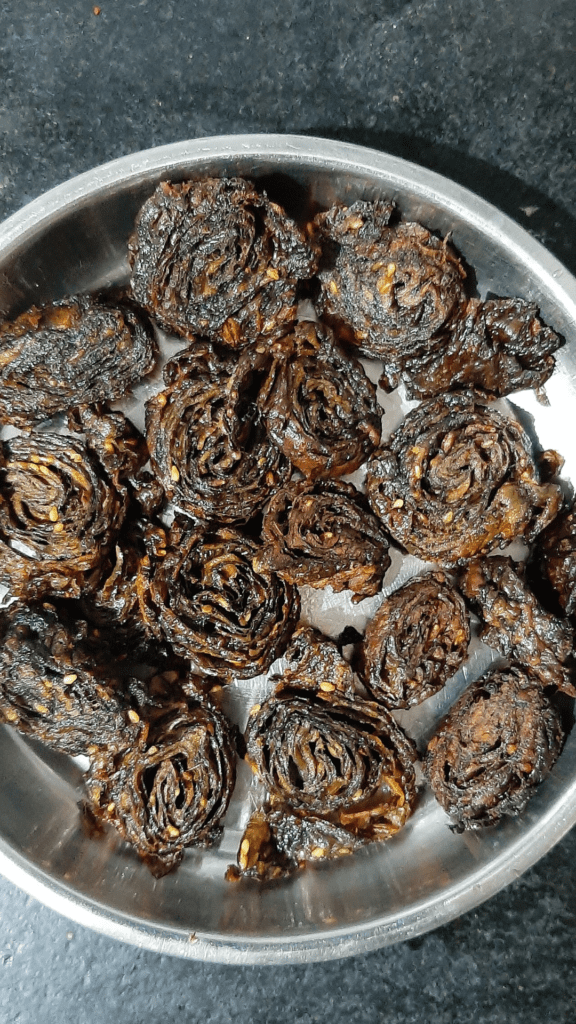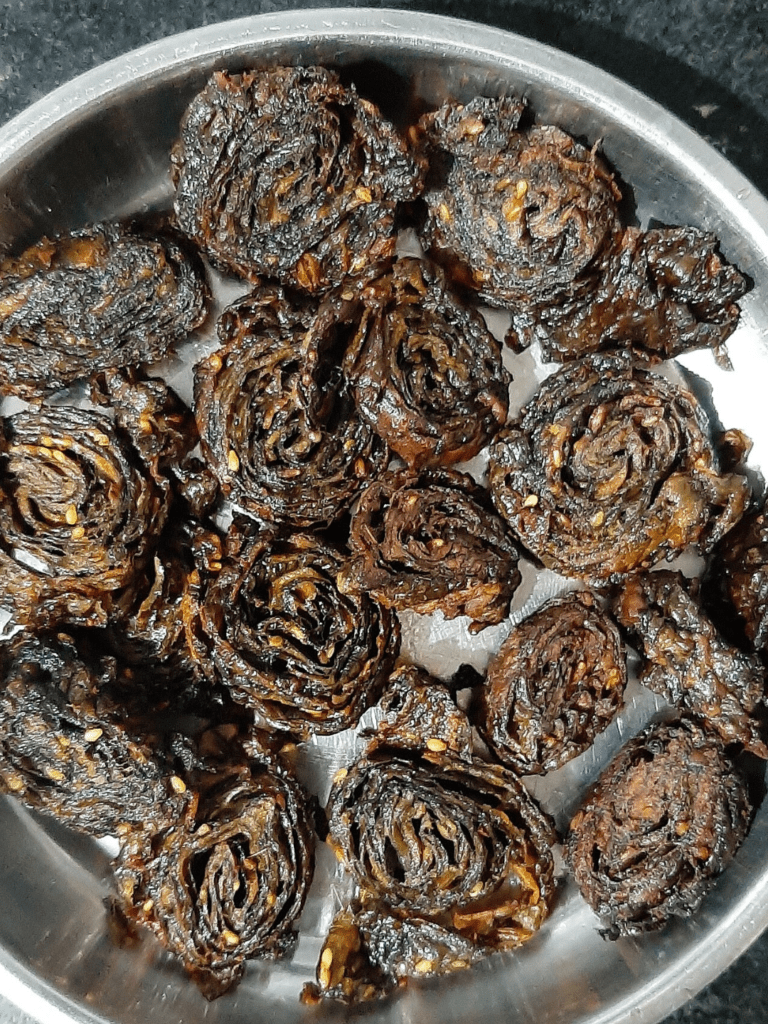Introduction
The cuisine of Maharashtra is an actual gold mine of tastes, customs, and culinary skill. Alu Wadi, a savory snack that combines the earthiness of colocasia leaves with a spicy gram flour filling, is one of the jewels from this colorful cuisine. This dish is a delightful treat for regular meals as well as a favorite at celebratory gatherings. Explore the world of Alu Wadi and learn how to prepare this delectable meal at home.

Ingredients for Alu Wadi Recipe
- 10 colocasia (taro) leaves
- 1 cup gram flour (besan)
- 2 tablespoons tamarind pulp
- 1 tablespoon grated jaggery
- 2 teaspoons ginger-garlic paste
- 2 teaspoons green chili paste
- 1 teaspoon turmeric powder
- 1 teaspoon red chili powder
- 1 teaspoon garam masala
- 1 teaspoon coriander powder
- 1 teaspoon cumin seeds
- 1 teaspoon mustard seeds
- 1/2 teaspoon asafoetida (hing)
- Salt to taste
- Water as needed
- Oil for frying
How to Make Alu Wadi
Preparing the Colocasia Leaves
- Selecting the ideal colocasia leaves is essential to creating the ideal Alu Wadi. Choose large, fresh leaves that are free of blemishes. Here’s how to get them ready:
- Clean the Leaves: To get rid of any dirt, give the leaves a thorough wash under running water.
- Trim the Stems: To make the leaves pliable for rolling, trim off any hard veins and thick stems.
Making the Filling
- Alu Wadi’s filling, which is filled with spices and flavors, is its core. This is how to do it:
- Add the ingredients: The gram flour, jaggery, tamarind paste, red chili powder, turmeric, coriander, cumin, garam masala, asafoetida, sesame seeds, grated coconut, and salt must all be combined in a mixing bowl.
- Add Water: To create a thick, smooth paste, gradually add water to the mixture while mixing carefully.
Covering the Leaves with Filling
- Organize the Leaves: Place a leaf flat with its darker side facing downward on a spotless surface.
- Put the Filling in: Using a spoon or spatula, evenly spread a thin layer of the gram flour paste over the leaf.
- Layering: Repeat the process with a second leaf on top. Arrange three to four leaves, a layer of filler between them.
Taking Leaves Rolling
- Properly rolling the leaves guarantees that the filling remains intact.
- Fold the Edges: Tuck the leaf margins inside.
- Roll Tightly: Roll the leaves tightly into a cylinder, starting at the bottom.
- Fasten the Roll: To stop the roll from unraveling while steaming, fasten it with thread if necessary.
Steaming the Rolls
- To cook the gram flour mixture and soften the leaves, steaming is necessary:
- Get the steamer ready: Water should be added to a steamer and brought to a boil.
- Arrange the Rolls: The steamer basket should hold the rolled leaves.
- Steam: When the rolls are firm to the touch, about 20 to 25 minutes should pass under cover and steam.
slicing the rolls
- After steaming, allow the rolls to cool slightly before slicing:
- Cool: Let the rolls come down to room temperature entirely.
- Slice the Rolls: Cut the rolls into 1/2-inch-thick slices with a sharp knife.
Frying the Alu Wadi
- Frying gives Alu Wadi its signature crispy texture: Heat the Oil: Heat the oil in a frying pan over a medium heat.
- Fry the Slices: Gently drop the slices into the heated oil and cook them until they are crispy and golden brown on both sides.
- Remove Extra Oil: Take out the fried pieces and use paper towels to absorb any extra oil.
Health Benefits
While Alu Wadi is a delicious treat, it also packs some nutritional benefits:
- Rich in Fiber: Dietary fiber from colocasia leaves helps with digestion.
- Vitamins and Minerals: Iron, calcium, and vitamins A and C are all present in good amounts.
- Low in Calories: If eaten in moderation, Alu Wadi, despite being fried, can be a low-calorie snack.
Tips and Tricks
Here are some expert tips to perfect your Alu Wadi:
- Use Fresh Leaves: For the greatest flavor and texture, always use fresh colocasia leaves.
- Even Spreading: To guarantee a constant flavor, spread the filling equally.
- Correct Steaming: In order to prevent a raw taste, make sure the rolls are steam-cooked.
Conclusion
Cooking Maharashtrian Alu Wadi at home is an opportunity to engage with rich traditions as well as partake in a culinary adventure. With its crispy outside and spicy, tangy filling, this tasty snack is sure to become a family favorite. Now get your hands dirty and try this recipe. Have fun in the kitchen!
You can also Check others Recipes

Alu Wadi Recipe (Maharashtrian Style)
Ingredients
Instructions
-
Prepare the Batter: In a mixing bowl, combine the gram flour, tamarind pulp, grated jaggery, ginger-garlic paste, green chili paste, turmeric powder, red chili powder, garam masala, coriander powder, and salt. Add water gradually to make a thick, smooth paste.
-
Prepare the Leaves: Wash the colocasia leaves thoroughly. Trim the thick veins on the back of the leaves without tearing them.
-
Assemble the Wadis: Place a leaf on a flat surface with the veins facing up. Spread a thin layer of the gram flour mixture evenly over the leaf. Place another leaf on top and spread more mixture. Repeat with the remaining leaves and mixture.Roll the layered leaves tightly into a cylindrical shape. Secure with kitchen thread if needed.
-
Steam the Roll: Place the roll in a steamer and steam for about 20-25 minutes or until firm. Remove from the steamer and let it cool completely.
-
Slice & Fry: Once cooled, slice the roll into 1/2 inch thick rounds.Heat oil in a frying pan. Add mustard seeds, cumin seeds, and asafoetida. When they start to crackle, add the sliced wadi and fry until golden brown on both sides.
-
Serve: Serve hot as a snack or side dish, garnished with fresh coriander leaves and a squeeze of lemon juice.
- Amount Per Serving
- Calories 320kcal
- % Daily Value *
- Total Fat 10g16%
- Saturated Fat 1.5g8%
- Sodium 450mg19%
- Total Carbohydrate 52g18%
- Dietary Fiber 8g32%
- Sugars 7g
- Protein 10g20%
* Percent Daily Values are based on a 2,000 calorie diet. Your daily value may be higher or lower depending on your calorie needs.

